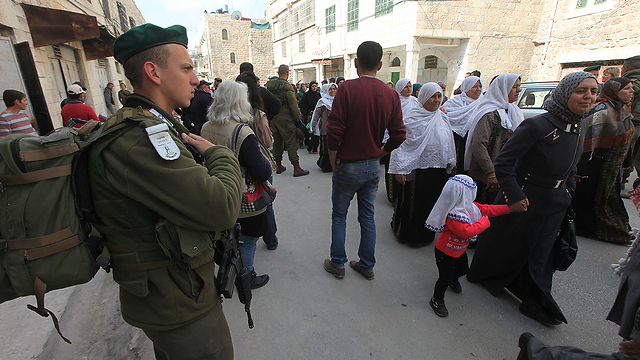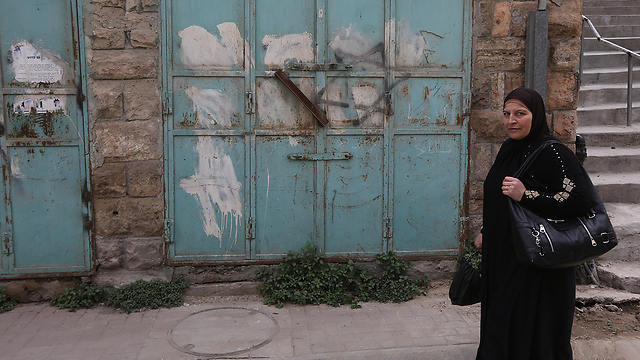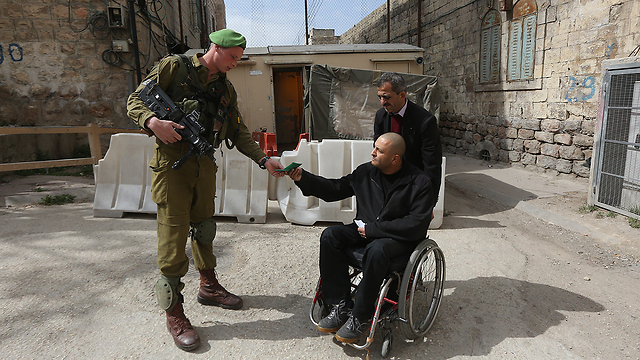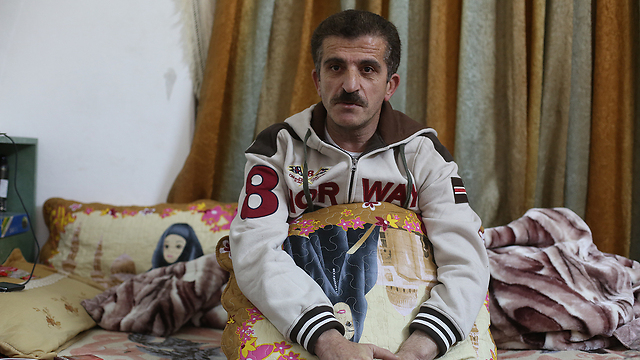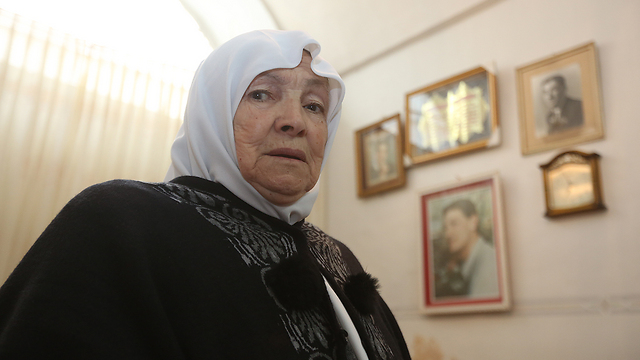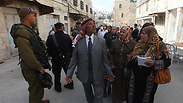
20 years after the Hebron massacre, life stands still
In the two decades that have passed since the murder of 29 people in The Cave of the Patriarchs, shops have closed, streets were deserted and the few remaining Palestinian residents lament apathy: 'The world carried on, but here nothing has changed.'
A short while later, a group of settlers from the Jewish part of the city arrive on the scene. Armed with plastic furniture, they set up two tables in front of the store's entry and unpack light refreshments. The goal of their visit: To block access to the shop, in protest of its renovation.
IDF and police forces, who are well aware of the volatile atmosphere in the city, arrived almost instantly to see what was behind the improvised picnic, and formed a buffer between the two sides before things got out of hand.
A few minutes later, UN forces from the Temporary International Presence in Hebron (TIPH) arrived, followed by more representatives from watchdog organizations – most of them unheard of by the Israeli public – like The Ecumenical Accompaniment Program in Palestine and Israel (EAPPI) and Christian Peacemaker Teams (CPT). Eventually, with the exception of a few swear words, the crisis was averted.
This bizarre mix of settlers, Palestinians, soldiers, policemen, UN forces and Scandinavian-looking observers, coexists in a territory of 50 square feet. This may seem like the opening line of a joke, but life in the H-2 territory, the Israeli controlled part of Hebron, over the last 20 years has been anything but a comic relief.
This was especially true on Wednesday, exactly two decades after Dr. Baruch Goldstein entered the Muslim prayer chamber in The Cave of the Patriarchs armed with an automatic rifle and opened fire. Twenty-nine Palestinians died and over a hundred were injured by the time the barrage of bullets had stopped, and Goldstein had been killed at the hands of his surviving victims. That fateful massacre changed the face of Hebron forever.
'We're the ones being punished'
Among the hundreds of worshipers who filled the prayer hall that deadly day was Kamal Al-Abadi, then 20-years-old, who worked in marketing for his family's shoes manufacturing business. Now he is in a wheelchair, after a bullet pierced his throat and damaged his spine. After sustaining the paralyzing wound, Al-Abadi lost consciousness and awoke only several months later, in Jordan.
“The Jordanian doctor arrived and told me I better get used to the fact I won't be able to walk anymore,” he recalled. From Israel, he said, he received a one-time compensation of NIS 100,000 ($ 28,400). He underwent physical therapy and now works as a clerk for the Palestinian Authority. He has devoted his life to promoting sports for the disabled and participates in international table tennis competition.
His city, on the other hand, never recovered. “We thought that the world would be on our side after the massacre, but we were the ones being punished again”.
It started with growing restrictions on Palestinians' freedom of movement, as well as the closing of some their shops in fear of additional vengeance. After the Second Intifada, the IDF increased its segregation policy, forcing many to close their main street shops, which were deserted by the residents in favor of other areas.
In the boulevard of closed shops lives Moped Sharabati. “We had a store which sold Hookahs and charcoal. The day of the massacre was the last day it was opened,” he said while chain-smoking and lying on a bed in the living room of his bleak home.
Until then, he claims, his five brothers lived in the adjacent houses and the shop was the source of the family's livelihood. “After the store closed, with the new and straining routine here, two of my brothers moved to the Palestinian part of Hebron and another brother moved to Ramallah”.
Have you also thought of leaving?
“I understand those who leave, but I will not buckle despite all the pressure. Somebody even offered us a check for NIS 1 million to evacuate our house”.
The two decades that have passed haven't filled him with much optimism. “The world carried on since that day, but here nothing changed. Our lives stopped,” he complains, sparing no criticism from the Palestinian Authority: “We receive no support from them”.
Rather die here
Khaled Khativ, a neighbor who joined the conversion at the Sharabati residence, tries to remain positive nonetheless. “In the first few years after the settlers arrived, our relationship (with them) was tolerable,” he claimed. “I thought they were interested in living peacefully together, but over the years they left and in their place came a group of extremists with whom we are having all this trouble.”
The rest of the people in the room interrupted him, claiming that no one moves to somebody else's territory with the intent to be neighborly. On one thing they could all agree: The massacre only strengthened the extremists on the Palestinian side and inspired suicide bombings inside Israel.
Again and again, the Palestinian residents described a feeling of abandonment. “Our lives became harder,” said Wadha Al-Bayed, an elderly woman, whose son Arafat was killed in the massacre.
According to her, The Red Cross used to hand out food to the needy, but had stopped doing so in recent years. Nowadays, she claims, only Hamas-owned charities continue to help. “That's also not enough,” she added. “Anyone with children has already left and moved somewhere else, but I've stayed. I'd rather die in this house.”
The walk back from her house to The Cave of the Patriarchs painted a depressing image: The streets were empty, the shops were closed and the entrance was blocked with metal bars covered with Stars of David graffiti as well as the word "Hamas" in Arabic.
The entrances that once connected the north and south sides of town are now sealed off with cement blocks, and the silence is interrupted only once in a while by the sounds of a settler's car, a military jeep or a vehicle belonging to a human rights organization, monitoring any interaction that could ignite the barrel of gunpowder, which is neatly referred to as H-2.










